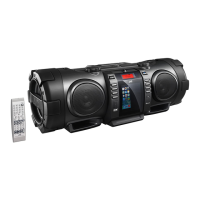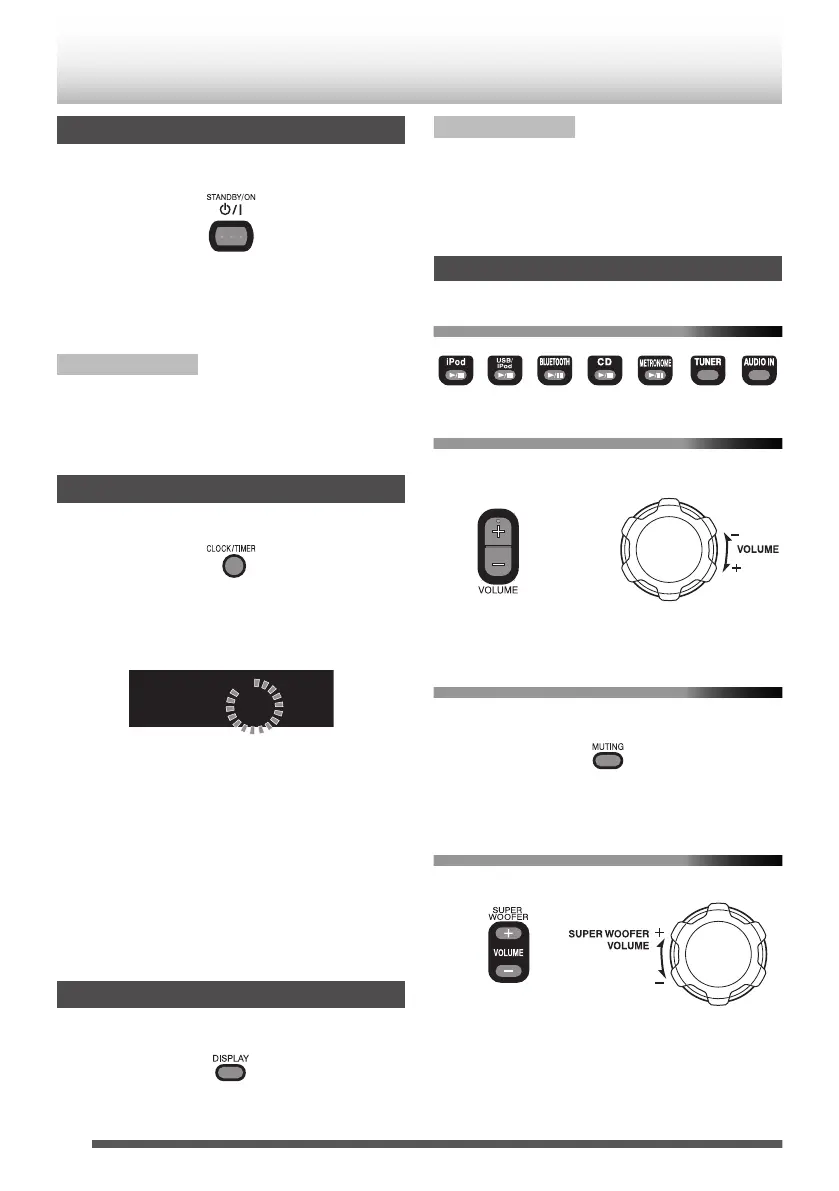

Do you have a question about the JVC RV-NB100B and is the answer not in the manual?
| Type | Portable CD Player |
|---|---|
| Bluetooth | Yes |
| Bass Boost | Yes |
| Playback Formats | MP3, WMA |
| Anti-Skip Protection | Yes |
| Playable Media | CD |
| Connectivity | Bluetooth, AUX |
| Tuner | FM |
| Headphone Output | 3.5mm |
System turns off automatically after 15 minutes of inactivity.
Important precautions for safe and proper system operation.
Class 1 laser product safety precautions and servicing guidelines.
Guidelines for safe placement and ventilation to prevent damage and ensure proper function.
Play music from iPod/iPhone and stream from Bluetooth.
Play audio from CDs and USB drives.
Record to USB and mix microphone/guitar inputs.
Adjust super woofer volume and sound modes.
List of included items such as power cord, remote, strap, and buckle.
Instructions for inserting batteries into the main unit and remote control.
Properly hold both handles to avoid dragging and damage.
Attaching and using the adjustable shoulder strap for portability.
Identification of buttons, connectors, and indicators on the front panel.
Identification of input/output jacks and antenna on the rear of the unit.
Explanation of symbols and information shown on the system's display.
Mapping of remote control buttons to system operations and page references.
Steps to connect the system to a wall outlet for power.
How to connect headphones, which deactivates the speakers.
Procedures for powering the system on and off using the main unit or remote.
Instructions for setting the current time and displaying it on the unit.
How to adjust the main volume, mute sound, and control super woofer volume.
Choosing preset sound modes like POP, CLEAR, USER, or FLAT.
Customizing sound quality by adjusting treble and bass levels.
Enabling/disabling the automatic shutdown feature to save power.
Steps to connect compatible iPods/iPhones to the system's dock connector.
How to connect iPods/iPhones using the USB connector if they lack a Lightning connector.
Starting, pausing, and stopping playback of iPod music.
Skipping to the beginning of tracks or fast forwarding/reversing.
Putting the connected iPod into sleep mode.
Enabling random shuffle and various repeat playback modes.
Navigating and selecting options from the iPod/iPhone menu via the system.
Pairing a Bluetooth device with the system for initial connection.
Using the system's controls to manage playback of the connected Bluetooth device.
Turning the system's Bluetooth feature on or off.
Registering additional Bluetooth devices with the system.
Enabling standby mode for remote control via a Bluetooth app.
Instructions for using the 'JVC Audio Control BR1' app on Android devices.
Loading CDs and connecting USB devices for playback.
Starting, stopping, pausing, and navigating tracks during playback.
Selecting specific tracks and navigating groups on discs/USB.
Creating custom playlists by programming up to 32 tracks.
Deleting tracks from programs, exiting modes, and controlling random playback.
Selecting repeat modes for current track, group, or all tracks.
Tuning in and selecting services from DAB/DAB+ broadcasts.
Scanning for ensembles and manually presetting up to 30 DAB services.
Locating specific program types using PTY codes.
Optimizing reception by adjusting the telescopic antenna.
Tuning stations and storing up to 30 FM presets.
Selecting MONO mode for better reception of weak stereo signals.
Connecting and playing audio from external devices via the AUDIO IN jack.
Setting the input level to match external device volume.
Activating and setting the tempo and beat for the metronome.
Mixing external microphone or guitar sound with playback sources.
Selecting different guitar amp tones using the remote or main unit.
Pressing the main unit button to toggle between super woofer and guitar tone adjustments.
Digital and analog recording of CDs to a USB device.
Setting the recording speed for digital recording from discs.
Steps for digitally recording all tracks from a music disc.
Steps for digitally recording a single track from a music disc.
Performing analog recording from CDs when digital is not possible.
Recording DAB/FM, metronome, or external devices.
Choosing how files are divided during recording (MANUAL or TIME).
Steps to tune and record DAB/FM radio broadcasts.
Recording the metronome function or external audio sources.
Steps to select and delete a specific track from a USB device.
Setting a time for the system to automatically turn off.
Setting a wake-up timer to play music from a selected source.
Setting start/end times, source, and volume for the daily timer.
Turning off the daily timer or setting it to PLAY ON/OFF.
Configuring the system to turn on and record at a scheduled time.
Disabling the scheduled recording function.
Re-enabling the scheduled recording with the same settings.
List of iPod and iPhone models supported by the system.
Requirements for Bluetooth device compatibility and supported profiles.
Information on supported disc formats and MP3/WMA file specifications.
Guidelines for connecting, disconnecting, and playing files from USB devices.
Organization of recorded music files on USB devices into folders.
Explanation of Serial Copy Management System restrictions on digital copying.
Proper methods for handling discs and cleaning them to prevent damage.
Instructions for cleaning the system unit and the CD pickup lens.
Information on trademarks like Microsoft, Apple, Bluetooth, and Android.
Resolving issues with power, automatic turn-off, and settings cancellation.
Troubleshooting problems with iPod playback and Bluetooth connectivity/operation.
Resolving issues with disc/USB playback, MP3/WMA groups, and interrupted USB sounds.
Troubleshooting poor radio reception and recording failures.
Resolving issues with sleep, daily, and recording timers not functioning correctly.
Technical data for CD capacity, signal-to-noise, tuning ranges, and antenna type.
Specifications for Bluetooth version, output power, frequency band, and speaker characteristics.
Details on input terminals like USB, iPod dock, and audio in, plus USB memory compatibility.
Specifications for input sensitivity, microphone/guitar impedance, power supply, and consumption.
Physical dimensions and weight of the system unit.